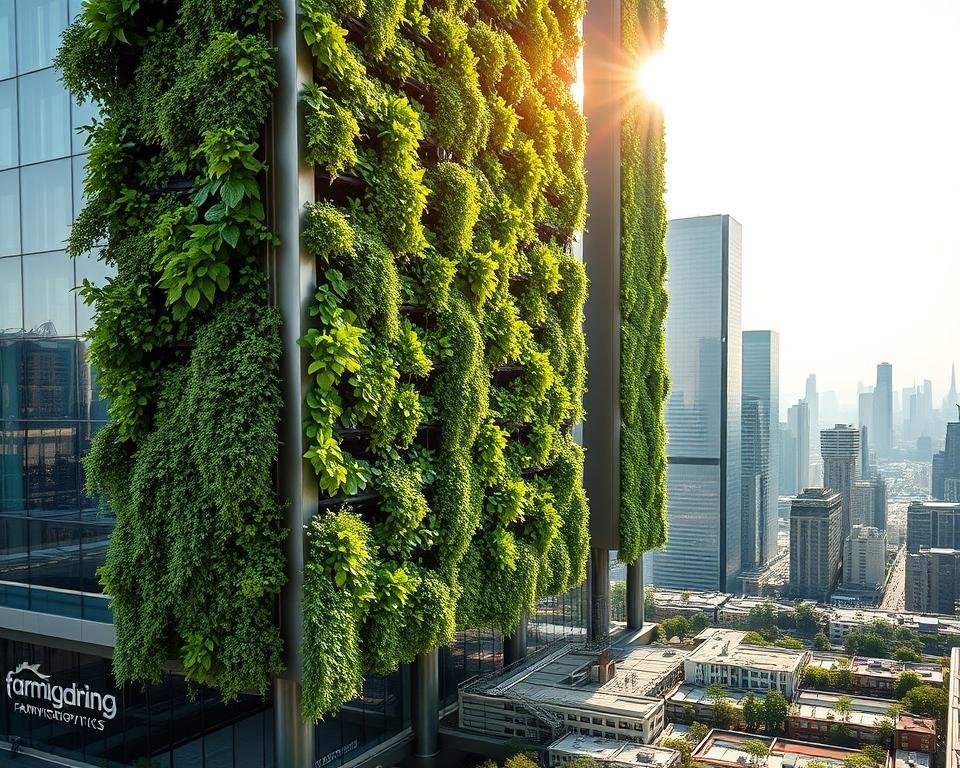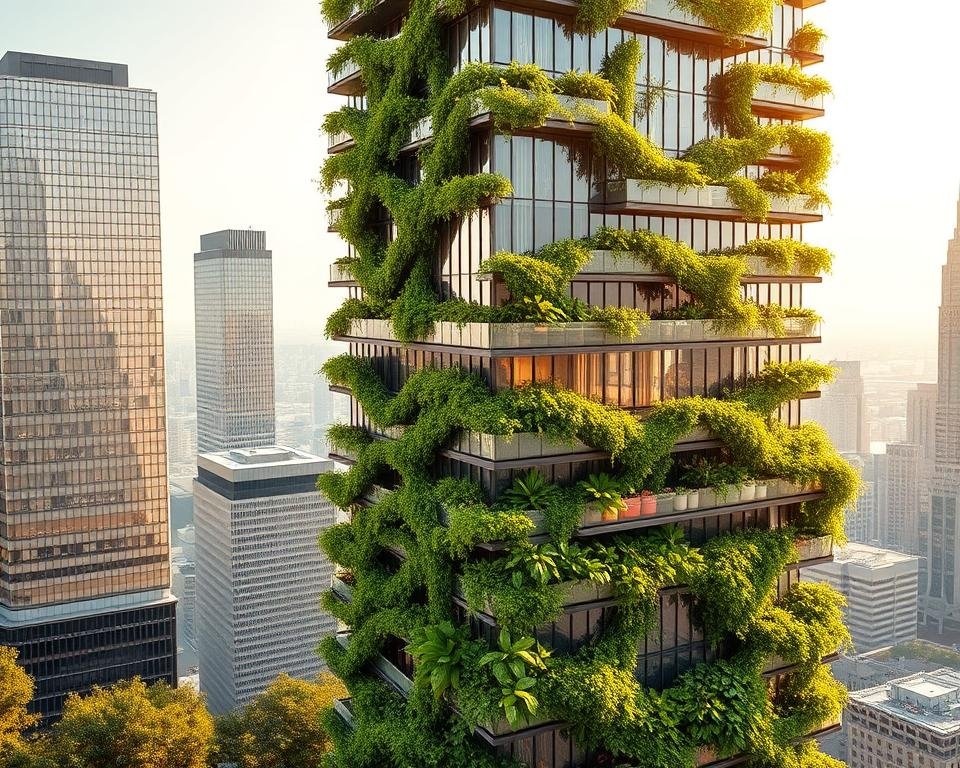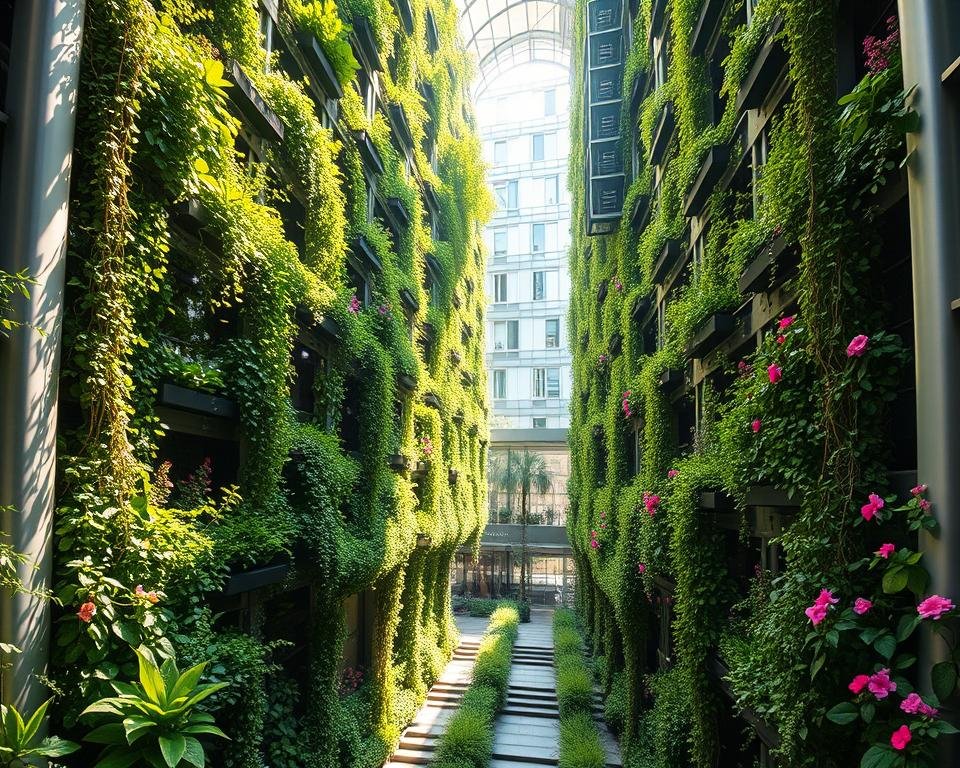Living Architecture: The Future of Vertical Gardens
In the heart of modern cities, it’s easy to feel far from nature. The city’s growth seems to push us away from green spaces. But what if buildings could actually bring life to our urban world?
Vertical gardens are changing how we see cities. The United Nations says by 2050, most people will live in cities. These green walls offer a way to make cities greener and more alive.
Picture skyscrapers covered in plants, where walls turn into gardens. These green walls are more than pretty views. They help clean the air, save energy, and bring people closer to nature.
Key Takeaways
- Vertical-gardens transform urban landscapes into sustainable ecosystems
- Living architecture supports urban population growth challenges
- Green walls improve air quality and reduce environmental stress
- Innovative design integrates nature with modern architectural practices
- Vertical-gardens enhance human productivity and well-being
Understanding the Rise of Urban Vertical Gardens
As more people move to cities, cities face big challenges. Over 50% of the world’s people live in cities now. This means we need new ways to live sustainably, using less space and making life better.
Vertical-gardens are a new idea in city planning. They turn city areas into green spaces. These gardens bring many benefits, like cleaner air and cooler temperatures.
- Maximize limited urban space
- Improve air quality
- Reduce urban heat island effects
- Enhance biodiversity
- Provide natural insulation
The Urban Population Challenge
Urban growth has harmed the environment. Vertical-gardens are a smart fix. They let cities add green spaces without taking up more land. This helps the environment and makes cities better places to live.
From Concrete Jungles to Green Towers
Thanks to new tech and caring for the planet, cities are changing. Architects use green tech to make buildings that are alive. Smart building technologies help save energy, keeping us comfortable while using less.
The Evolution of Living Walls
Vertical-gardens have grown from simple ideas to complex systems. New tech like smart watering and special growing materials make these gardens better. They support many plants and create thriving urban areas.
Living Architecture: Transforming Modern Cityscapes

Urban landscapes are changing fast thanks to biophilic architecture. Vertical-gardens are making cities greener, turning buildings into living spaces. As cities grow, new eco-friendly ways to build are solving urban problems.
Vertical-gardens in skyscrapers are changing how we see cities. Now, cities are seen as lively places where nature and buildings work together. For example, Milan’s Bosco Verticale shows how green buildings can change city looks.
- Vertical-gardens reduce urban heat island effect
- Improve air quality in dense metropolitan areas
- Create visually stunning architectural landmarks
- Enhance biodiversity within urban environments
By 2050, almost 68% of people will live in cities. This shows how important green building solutions are. Vertical-gardens bring many benefits, like:
| Benefit | Impact |
|---|---|
| Energy Efficiency | Reduces cooling needs by up to 50% |
| Air Quality | Removes 30% of particulate matter |
| Property Value | Increases by 15-20% |
Looking at modern city design, vertical-gardens are more than just pretty. They are key to making cities sustainable and livable, focusing on people and the planet.
Environmental Benefits of Vertical Garden Systems
Urban areas are seeing a green change with living walls. These walls turn concrete into green spaces. They solve many environmental problems cities face.
Vertical garden systems bring big wins for urban forestry and green design. They offer many benefits that traditional landscaping can’t match.
Air Quality and Carbon Reduction
Living walls clean the air in cities. They:
- Capture pollutants like carbon monoxide and nitrogen oxides
- Filter toxins with plant roots
- Make oxygen and cut down carbon dioxide
Temperature Regulation and Energy Efficiency
Vertical-gardens use nature to cool cities. They:
- Lessen the urban heat island effect
- Act as natural insulation
- Save energy on heating and cooling
Biodiversity Enhancement in Urban Areas
Vertical-gardens are homes for city wildlife. They:
- Give shelter to pollinators and small animals
- Support local plants
- Link green spaces together
Adding living walls is more than design. It’s creating a sustainable ecosystem that brings life to cities.
Technical Aspects of Vertical Garden Implementation

Setting up vertical-gardens needs advanced technical skills. It combines nature-inspired designs with the latest in sustainable design. These green walls turn city spaces into lush areas, making the most of vertical space.
The process has several key steps:
- Comprehensive site assessment
- Detailed architectural design
- Structural installation
- Functionality testing
Success in vertical gardening comes from careful planning. Evaluating the site is crucial. It looks at:
- Sunlight exposure
- Ventilation patterns
- Regional climate conditions
- Structural support capabilities
Modern tech is vital for vertical-gardens. Fertigation systems give plants the right water and nutrients. This smart irrigation cuts down water use while keeping plants healthy.
Keeping your garden in top shape is also key. Some need regular trimming, but options like MOSSwall® don’t. Your choice depends on what you want and need, letting you design a garden that fits your space and style.
Vertical-gardens represent a transformative approach to urban greening, merging technology with natural ecosystems.
Innovative Design Solutions in Modern Skyscrapers
Green buildings are changing cityscapes with advanced vertical garden tech. Architects turn concrete into eco-friendly spaces that mix design, green living, and new ideas.

Today’s skyscrapers use new biophilic architecture. This makes buildings more than just structures. They become living parts of the city, helping the environment.
Hydroponic Systems Integration
Hydroponics let plants grow well in vertical spaces. These systems give plants the right nutrients and water. This way, green buildings can have plants even high up.
- Automated irrigation controls
- Nutrient-optimized growing environments
- Lightweight modular planting systems
Plant Selection Strategies
Choosing the right plants is key for vertical-gardens. Architects must think about the local weather, sunlight, and building direction. This helps create green buildings that work well.
- Drought-resistant native plants
- Low-maintenance vegetation
- Climate-adaptive species
Structural Support Considerations
Adding vertical-gardens needs smart engineering. Special systems hold up the plants without harming the building. They also stop water damage.
Sustainable skyscrapers can cut carbon emissions by 30%. They use energy-saving designs and green ideas. This makes buildings good for the planet and looks great too.
Notable Examples of Vertical Gardens Worldwide
Vertical gardens are changing cities worldwide, turning them into green spaces. These projects show how design can change our cities. Architects in places like Milan and Singapore are leading the way, adding green areas to cities.
Some examples of vertical gardens are truly impressive:
- Bosco Verticale in Milan has two towers with over 900 trees and 20,000 plants. They absorb a lot of carbon dioxide and make a lot of oxygen every year.
- The Nanjing Green Towers have over 800 trees and 2,500 shrubs. They cut down CO2 emissions by about 18 tons each year.
- Oasia Hotel Downtown in Singapore has a lot of green space, thanks to its Green Plot Ratio of 1,100%.
These vertical gardens do more than make cities look good. They help the environment by improving air quality and reducing heat. The Clearpoint tower in Sri Lanka is the tallest residential vertical garden, with 46 floors and 164 apartments.
Your future city will be green. As cities get bigger, vertical gardens are a smart way to use space. They change how we think about living in cities and design.
Conclusion
Vertical gardens are changing urban design, making green buildings and sustainability more important. As cities grow, knowing about eco-friendly buildings is key to solving environmental problems.
Living architecture does more than look good. It improves health, work performance, and helps nature in cities. New tech will make vertical gardens easier to use and see in our cities.
Working together, architects, planners, and leaders can make green buildings bigger. Your support for green cities helps make them better for people and the planet.
Vertical gardens will soon be more than just buildings. They will be essential for healthy, green cities. Our cities’ future depends on using these green solutions to connect with nature.







